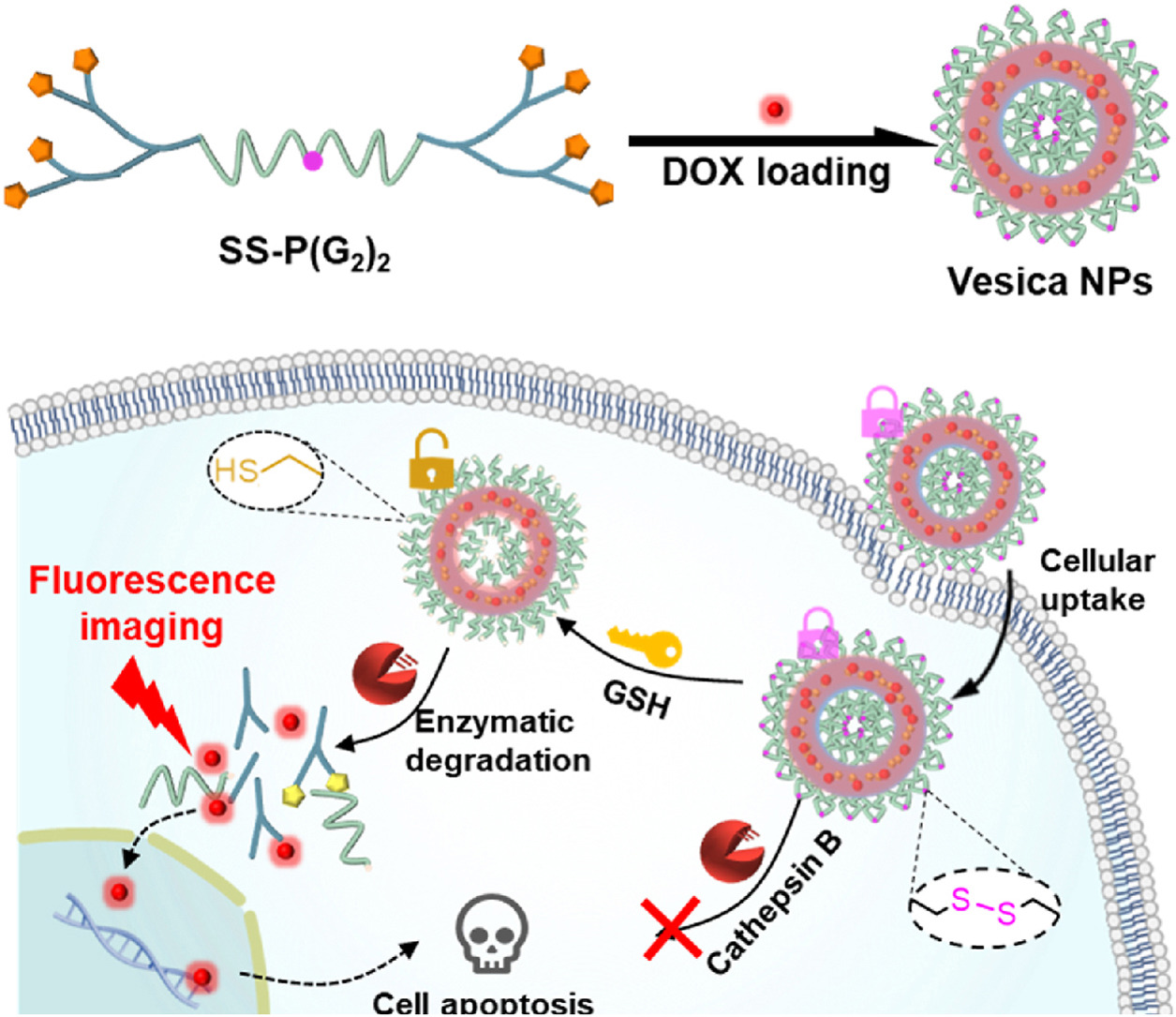博文
云师大化工学院毕韵梅教授课题组在top期刊《Talanta》发表最新研究成果
||
2024年6月14日,Elsevier 旗下top期刊《Talanta》在线发表了云南师范大学化学与化工学院毕韵梅教授课题组最新研究成果《Disulfide bonds as a molecular switch of enzyme-activatable anticancer drug precise release for fluorescence imaging and enhancing tumor therapy》。云南师范大学化学化工学院毕韵梅教授为通讯作者。
https://www.sciencedirect.com/science/article/pii/S0039914024007732#undfig1

Abstract
Enzyme-activatable drug delivery systems have been developed for cancer diagnosis and therapy. However, targeted intracellular drug delivery is a challenge for precisely tumor imaging and therapy due to the increased stability of copolymer nanoparticles (NPs) is accompanied by a notable decrease in enzyme degradation. Herein, disulfide bond was designed as an enzyme-activatable molecular switch of SS-P(G2)2/DOX NPs. The copolymer NPs consists of polyvinylpyrrolidone (PVP) with disulfide bonds in the center and enzyme-degradable peptide dendrites (Phe-Lys) to form dendritic-linear-dendritic triblock copolymers (TBCs). The amphiphilic TBCs could be split into two identical amphiphilic diblock copolymers (DBCs) by glutathione (GSH) in cancer cells specifically while maintaining the same hydrophilic-lipophilic equilibrium. This structural transformation significantly reduced the stability of copolymer NPs and enhanced sensitivity of DOX release by cathepsin B-activated. Subsequently, the released DOX acted as an indicator of fluorescence imaging and chemotherapy drug for cancer cells. The polymeric NPs achieved excellent drug-loaded stability and prolonged blood circulation in vivo, and realized fluorescence imaging and specific cancer cell killing capabilities by responding to the overexpression of GSH and cathepsin B in tumor cells. Furthermore, the copolymer NPs demonstrated excellent blood compatibility and biosafety. Therefore, a novel strategy based on one tumor marker acting as the switch for another tumor microenvironment responsive drug delivery system could be designed for tumor intracellular imaging and chemotherapy.

Graphical abstract
A highly stable hydrophobic-hydrophilic-hydrophobic three blocks copolymer nanocarriers with the disulfide bond in the center has been designed to respond by tumor-overexpressed GSH, and transform into half molecular weight and enzyme-accessible diblock copolymer nanocarrier. This design enhanced drug-loaded stability of NPs and prolonged blood circulation in vivo, and realized specific fluorescence imaging and antitumor activity by responding to the overexpression of GSH and cathepsin B in tumor cells.
扩展阅读:
https://hgxy.ynnu.edu.cn/szdw/jxms/bym_js/grzl/grjl.htm
毕韵梅,女,教授,博士,硕士生导师。云南省中青年学术技术带头人。云南省《有机化学》精品课程负责人。
1985年在云南大学获学士学位,1988年在云南大学获硕士学位,1988年至1999年在云南教育学院化学系任教。2001年在中国科学院兰州化物所获博士学位。2001年至2002年,在美国宾夕法尼亚州立大学作访问学者。1999年至今,在云南师范大学化学化工学院任教。
从教二十多年来,始终坚持在教学第一线,主讲本科生专业基础课《有机化学》二十年及《功能高分子》等12门课程。主讲研究生学位基础课《高等有机化学》,现正主持云师大研究生教学改革项目“《高等有机化学》示范课程建设”。自制有关课程教学课件5套。副主编编写出版教材《植物化学成分》。
主持科研项目13项,其中国家自然科学基金3项,省部级4项,横向课题1项;已完成11项。发表科研论文80余篇,SCI收录十多篇,其余多发表于国家级核心刊物。获发明专利授权一项。
曾获云南省普通高等学校教学成果一等奖,制作的教育软件获云南省优秀多媒体软件大赛二等奖,获云师大 “伍达观教育基金”奖教金三等奖、 “高层次科研项目奖” 、“高层次论文奖”。在 “三沟通”学历进修工作中被评为“优秀授课教师”。被云南省教育卫生科研工会评为“先进女职工”。
https://blog.sciencenet.cn/blog-454141-1438447.html
上一篇:云南师范大学2024年1至5月发表的CSSCI论文目录
下一篇:云师大化工学院赵焱教授、何俊男、晏瑾等在top期刊《Carbohydrate Polymers》发表最新研究成果